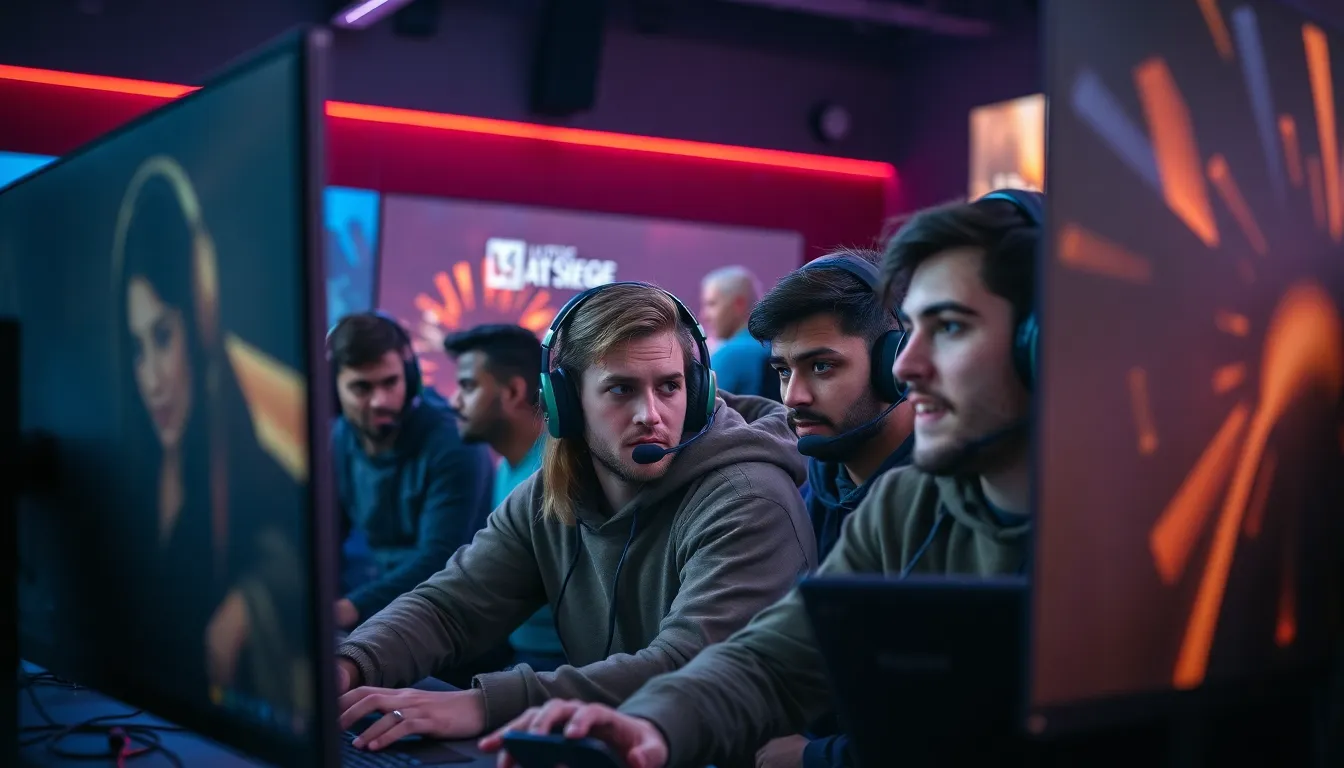Table of Contents
ToggleIn the world of Rainbow Six Siege, ranked distribution is like a secret sauce that can make or break a player’s journey to glory. Ever wondered why some players seem to float effortlessly through the ranks while others are stuck in the trenches? It’s not just skill; it’s about understanding the ranked ecosystem.
Overview Of R6S Ranked Distribution
Ranked distribution in Rainbow Six Siege illustrates player performance across various tiers, influencing progression and matchmaking. Players fall into diverse ranks, such as Copper, Silver, Gold, Platinum, Diamond, and Champion. This ranking system operates on a competitive framework designed to match players of similar skill levels, ensuring balanced gameplay.
Performance metrics play a vital role in determining rank placement. Wins, losses, and kill-to-death ratios significantly affect player rankings. High win rates often correlate with elevated ranks, while a consistent performance results in higher placement over time.
Statistics reveal that a majority of players often occupy the lower ranks. As of recent data, over 50% of players find themselves in Copper and Silver tiers. This trend emphasizes the competitive nature of the game, as only a small fraction manages to reach Platinum or higher.
Understanding the ranked distribution aids players in improving their gameplay. Players looking to ascend should focus on enhancing their skills and adapting strategies suited for their current rank. Matching the gameplay techniques to rank-specific challenges promotes steady advancement.
Rewards and incentives also tie closely to ranked distribution. Players achieving higher ranks can unlock exclusive rewards, which serve as motivation for continuous improvement. Focused efforts in mastering game mechanics and teamwork yield tangible benefits in the ranked system.
Ultimately, recognizing how ranked distribution functions in Rainbow Six Siege provides insights into both personal performance and the broader competitive landscape. Consistent engagement with the ranked system leads to better understanding and improved ranks over time.
Factors Influencing Ranked Distribution

Ranked distribution in Rainbow Six Siege is influenced by several key factors. These factors contribute to how players navigate the competitive landscape.
Matchmaking System
The matchmaking system plays a crucial role in rank placement. It evaluates a player’s skill rating, ensuring each match consists of players with similar capabilities. High skill ratings lead to matches against stronger opponents, which can pressure players to enhance their strategies and teamwork. Adjustments in the system also reflect players’ recent performances, making it essential to maintain consistent gameplay. For example, a string of losses could result in a downward shift in rank, while victories can propel players upward. This dynamic structure helps maintain balance and fairness in the game.
Player Skill Levels
Player skill levels determine rank distribution significantly. Each tier, from Copper to Champion, represents various comprehension and execution of gameplay mechanics. Many players in lower ranks may struggle with basic strategies and communication, impacting their ability to win matches. Conversely, those in higher ranks typically exhibit advanced skills, including map knowledge and teamwork. Understanding personal strengths and weaknesses leads to better adaptation in gameplay. Players often benefit from focusing on specific areas for improvement, such as aiming or game sense. Engaging with higher-tier players can also provide valuable insights into effective strategies, facilitating upward movement through the ranks.
Current Trends In R6S Ranked Distribution
Recent trends highlight significant dynamics in Rainbow Six Siege ranked distribution. Understanding these trends helps players navigate their competitive journey.
Season-Specific Changes
Each season introduces adjustments in ranked distribution. Seasonal changes often reset player rankings, prompting a fresh start. Players frequently notice shifts in matchmaking, as updated maps and operators impact game strategies. Data from earlier seasons indicates fluctuations in player populations across ranks. Certain seasons experience an influx of new players, while seasoned veterans may gravitate towards higher tiers. Seasonal adjustments result in variations in win rates, influencing overall ranking.
Gameplay Impact
Gameplay significantly reflects ranked distribution trends. Players at higher ranks frequently exhibit advanced strategies and teamwork. These tactics, including effective communication and coordination, enhance match performance. Players positioned in lower ranks tend to emphasize fundamental gameplay skills, often leading to increased learning curves. Statistics reveal that higher-tier players maintain better win rates against lower-tier opponents. Understanding these dynamics can enlighten players on skill enhancements necessary for climbing ranks. Additionally, the competitive environment fosters adaptability, motivating players to evolve their strategies in response to opponent skill levels.
Community Reactions To Ranked Distribution
Community members actively discuss ranked distribution in Rainbow Six Siege, sharing diverse opinions on its fairness and impact. Players frequently express frustrations over perceived disparities in matchmaking, often highlighting that their skill levels do not align with opponents faced. Many believe the system favors certain playstyles, while others advocate for changes to the ranking mechanics. Engaging with these discussions provides insights into player sentiments and expectations regarding their progression.
Player Feedback
Feedback from the player base consistently reveals concern over the matchmaking system’s reliability. Issues arise when lower-ranked players compete against higher-ranked opponents, resulting in unbalanced matches. Players frequently suggest adjustments to matchmaking algorithms to better reflect individual skill ratings. They emphasize that improved communication about rank placement would enhance transparency. Suggestions also include refining win-loss metrics to create a more accurate depiction of player abilities. Overall, community discussions reflect a strong desire for equitable gameplay experiences.
Competitive Scene Analysis
The competitive scene in Rainbow Six Siege shows notable trends tied to ranked distribution. Observations indicate that top-ranked players often utilize advanced strategies that differ significantly from those used in lower tiers. These high-level players display exceptional teamwork and communication skills, setting benchmarks for performance. Teams in higher ranks adjust their tactics based on real-time feedback from matches, further emphasizing the importance of skill development. New seasons frequently introduce changes that shape the competitive landscape, influencing team dynamics and individual progression. Monitoring these developments helps players align their strategies with the evolving meta.
Understanding ranked distribution in Rainbow Six Siege is essential for players aiming to enhance their performance and climb the ranks. By recognizing how skill levels and matchmaking influence rank placement players can better navigate their competitive journey. The insights gained from analyzing player performance metrics and community feedback can lead to improved strategies and gameplay.
As the game evolves with each season adjustments to the ranked system will continue to shape the competitive landscape. Embracing these changes and focusing on personal growth will empower players to tackle challenges and achieve their desired ranks. Ultimately a thorough grasp of ranked distribution not only enriches individual gameplay but also fosters a more balanced and engaging experience for the entire community.




